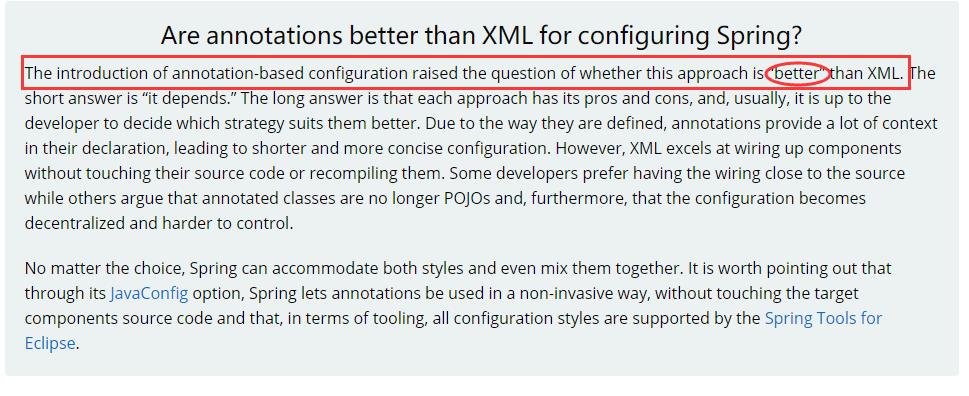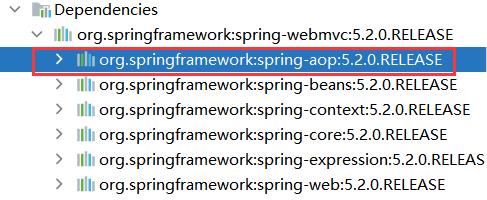Springbean的自动装配,使用注解开发,使用Java的方式配置Spring
Posted a碟
tags:
篇首语:本文由小常识网(cha138.com)小编为大家整理,主要介绍了Springbean的自动装配,使用注解开发,使用Java的方式配置Spring相关的知识,希望对你有一定的参考价值。
目录
1.bean的自动装配
- 自动装配是Spring满足bean依赖一种方式
- Spring会在上下文中自动寻找,并自动给bean装配属性
在Spring中有三种装配的方式
1.在xml中显示的配置
2.在java中显示配置
3.隐式的自动装配bean【重要】
1.1测试环境
1、新建一个项目
2、新建两个实体类,Cat ,Dog 都有一个shout()的方法
public class Cat {
public void shout() {
System.out.println("miao~");
}
}
public class Dog {
public void shout() {
System.out.println("wang~");
}
}
3、新建一个用户类 User
public class User {
private Cat cat;
private Dog dog;
private String name;
}
4、编写Spring配置文件
<?xml version="1.0" encoding="UTF-8"?>
<beans xmlns="http://www.springframework.org/schema/beans"
xmlns:xsi="http://www.w3.org/2001/XMLSchema-instance"
xsi:schemaLocation="http://www.springframework.org/schema/beans
http://www.springframework.org/schema/beans/spring-beans.xsd">
<bean id="dog" class="com.adie.pojo.Dog"/>
<bean id="cat" class="com.adie.pojo.Cat"/>
<bean id="user" class="com.adie.pojo.User">
<property name="cat" ref="cat"/>
<property name="dog" ref="dog"/>
<property name="name" value="adie"/>
</bean>
</beans>
5、测试
public class MyTest {
@Test
public void testMethodAutowire() {
ApplicationContext context = new ClassPathXmlApplicationContext("beans.xml");
User user = (User) context.getBean("user");
user.getCat().shout();
user.getDog().shout();
}
}
结果正常输出,环境正常
1.2byName自动装配
byName:会自动在容器上下文中查找,和自己对象set方法后面的值对应的beanid!
byName的时候,需要保证所有的bean的id唯一,并且这个bean需要和自动注入的属性的set方法的值一致
<!--byName:会自动在容器上下文中查找,和自己对象set方法后面的值对应的beanid!-->
<!--byName的时候,需要保证所有的bean的id唯一,并且这个bean需要和自动注入的属性的set方法的值一致-->
<bean id="people" class="com.adie.pojo.People" autowire="byName">
<property name="name" value="a碟!"/>
</bean>
当一个bean节点带有 autowire byName的属性时。
- 将查找其类中所有的set方法名,例如setCat,获得将set去掉并且首字母小写的字符串,即cat。
- 去spring容器中寻找是否有此字符串名称id的对象。
- 如果有,就取出注入;如果没有,就报空指针异常。
1.3byType自动装配
byType:会自动在容器上下文中查找,和自己对象属性类型相同的bean!
byType的时候,需要保证所有的bean的class唯一,并且这个bean需要和自动注入的属性的类型一致
<!--byType:会自动在容器上下文中查找,和自己对象属性类型相同的bean!-->
<!--byType的时候,需要保证所有的bean的class唯一,并且这个bean需要和自动注入的属性的类型一致-->
<bean id="people" class="com.adie.pojo.People" autowire="byType">
<property name="name" value="a碟!"/>
</bean>
1.4使用注解实现自动装配
jdk1.5支持注解 Spring2.5支持注解了

要使用注解须知:
1.导入约束:context约束
2.配置注解的支持 context:annotation-config/
<?xml version="1.0" encoding="UTF-8"?>
<beans xmlns="http://www.springframework.org/schema/beans"
xmlns:xsi="http://www.w3.org/2001/XMLSchema-instance"
xmlns:context="http://www.springframework.org/schema/context"
xsi:schemaLocation="http://www.springframework.org/schema/beans
https://www.springframework.org/schema/beans/spring-beans.xsd
http://www.springframework.org/schema/context
https://www.springframework.org/schema/context/spring-context.xsd">
<context:annotation-config/>
</beans>
@Autowired
直接在属性上使用即可,也可以在set方式上使用
使用AutoWired我们可以不使用Set方法了,前提是你这个自动装配的属性在IOC(Spring)容器中存在且符合类型bytype
-
@Autowired是按类型自动装配的,不支持id匹配。
-
需要导入 spring-aop的包!

测试:
1、将User类中的set方法去掉,使用@Autowired注解
public class User {
@Autowired
private Cat cat;
@Autowired
private Dog dog;
private String str;
public Cat getCat() {
return cat;
}
public Dog getDog() {
return dog;
}
public String getStr() {
return str;
}
}
2、此时配置文件内容
<context:annotation-config/>
<bean id="cat" class="com.adie.pojo.Cat"/>
<bean id="dog" class="com.adie.pojo.Dog"/>
<bean id="people" class="com.adie.pojo.People"/>
补充
@Autowired(required=false) 说明:false,对象可以为null;true,对象必须存对象,不能为null。
//如果允许对象为null,设置required = false,默认为true
@Autowired(required = false)
private Cat cat;
@Qualifier
- @Autowired是根据类型自动装配的,加上**@Qualifier则可以根据byName**的方式自动装配
- @Qualifier不能单独使用。
测试实验步骤:
1、配置文件修改内容,保证类型存在对象。且名字不为类的默认名字!
<bean id="cat1" class="com.adie.pojo.Cat"/>
<bean id="cat2" class="com.adie.pojo.Cat"/>
<bean id="dog1" class="com.adie.pojo.Dog"/>
<bean id="dog2" class="com.adie.pojo.Dog"/>
<bean id="people" class="com.adie.pojo.People"/>
2、没有加Qualifier测试,直接报错
3、在属性上添加Qualifier注解
@Autowired
@Qualifier(value = "cat2")
private Cat cat;
@Autowired
@Qualifier(value = "dog2")
private Dog dog;
测试
public class MyTest {
@Test
public void test1(){
ApplicationContext context = new ClassPathXmlApplicationContext("beans.xml");
People people = context.getBean("people", People.class);
System.out.println(people.toString());
people.getCat().shout();
people.getDog().shout();
}
}

成功输出!
@Resource
- @Resource如有指定的name属性,先按该属性进行byName方式查找装配;
- 其次再进行默认的byName方式进行装配;
- 如果以上都不成功,则按byType的方式自动装配。
- 都不成功,则报异常。
实体类:
public class User {
//如果允许对象为null,设置required = false,默认为true
@Resource(name = "cat2")
private Cat cat;
@Resource
private Dog dog;
private String str;
}
beans.xml
<bean id="cat1" class="com.adie.pojo.Cat"/>
<bean id="cat2" class="com.adie.pojo.Cat"/>
<bean id="dog2" class="com.adie.pojo.Dog"/>
<bean id="people" class="com.adie.pojo.People"/>
结果:成功

配置文件2:beans.xml , 删掉cat2
<bean id="dog" class="com.adie.pojo.Dog"/>
<bean id="cat1" class="com.adie.pojo.Cat"/>
实体类上只保留注解
@Resource
private Cat cat;
@Resource
private Dog dog;
结果:成功

结论:先进行byName查找,失败;再进行byType查找,成功。
小结
@Autowired与@Resource异同:
1、@Autowired与@Resource都可以用来装配bean。都可以写在字段上,或写在set方法上。
2、@Autowired默认按类型装配(属于spring规范),默认情况下必须要求依赖对象必须存在,如果要允许null 值,可以设置它的required属性为false,如:@Autowired(required=false) ,如果我们想使用名称装配可以结合@Qualifier注解进行使用
3、@Resource,默认按照名称进行装配,名称可以通过name属性进行指定。如果没有指定name属性,当注解写在字段上时,默认取字段名进行按照名称查找,如果注解写在set方法上默认取属性名进行装配。当找不到与名称匹配的bean时才按照类型进行装配。但是需要注意的是,如果name属性一旦指定,就只会按照名称进行装配。
它们的作用相同都是用注解方式注入对象,但执行顺序不同。@Autowired先byType,@Resource先byName。
2.使用注解开发
在Spring4之后,要使用注解开发,必须要保证aop的包导入了,在导入spring-webmvc的时候一般会导入aop的包

使用注解需要导入context约束,增加注解的支持!
<?xml version="1.0" encoding="UTF-8"?>
<beans xmlns="http://www.springframework.org/schema/beans"
xmlns:xsi="http://www.w3.org/2001/XMLSchema-instance"
xmlns:context="http://www.springframework.org/schema/context"
xsi:schemaLocation="http://www.springframework.org/schema/beans
https://www.springframework.org/schema/beans/spring-beans.xsd
http://www.springframework.org/schema/context
https://www.springframework.org/schema/context/spring-context.xsd">
<context:annotation-config/>
</beans>
2.1bean
1、配置扫描哪些包下的注解
<!--指定注解扫描包-->
<context:component-scan base-package="com.aide"/>
2、在指定包下编写类,增加注解
@Component("user")
// 相当于配置文件中 <bean id="user" class="当前注解的类"/>
public class User {
public String name = "a碟";
}
3、测试
@Test
public void test(){
ApplicationContext applicationContext =
new ClassPathXmlApplicationContext("beans.xml");
User user = (User) applicationContext.getBean("user");
System.out.println(user.name);
}
2.2属性如何注入
使用注解注入属性
1、可以不用提供set方法,直接在直接名上添加@value(“值”)
@Component("user")
// 相当于配置文件中 <bean id="user" class="当前注解的类"/>
public class User {
@Value("a碟")
// 相当于配置文件中 <property name="name" value="a碟"/>
public String name;
}
2、如果提供了set方法,在set方法上添加@value(“值”);
@Component("user")
public class User {
public String name;
@Value("a碟")
public void setName(String name) {
this.name = name;
}
}
2.3衍生的注解
@Component三个衍生注解
为了更好的进行分层,Spring可以使用其它三个注解,功能一样,目前使用哪一个功能都一样。
- @Controller:controller层
- @Service:service层
- @Repository:dao层
写上这些注解,就相当于将这个类交给Spring管理装配
2.4自动装配
@Autowired
@Qualifier
@Resource
前面已经讲过了
2.5作用域
@scope
- singleton:单例模式,默认的,Spring会采用单例模式创建这个对象。关闭工厂 ,所有的对象都会销毁。
- prototype:多例模式。关闭工厂 ,所有的对象不会销毁。内部的垃圾回收机制会回收
@Controller("user")
@Scope("prototype")
public class User {
@Value("a碟")
public String name;
}
2.6小结
XML与注解比较
- XML更加万能,可以适用任何场景 ,结构清晰,维护方便
- 注解不是自己提供的类使用不了,维护相对复杂
xml与注解整合开发 :
-
xml用来管理Bean
-
注解只负责属性的注入
-
使用过程中, 需要注意:必须让注解生效,就需要开启注解的支持
<context:annotation-config/>
2.7补充(关于注解驱动和指定扫描包)
上面的是指定的要扫描的包,下面的是注解驱动的支持,spring之外的注解也会支持
要将bean注册的注解必须要处于被扫描的包下
在指定要扫描的包之后,不需要注解驱动也能够使用该包下的注解
<!-- 指定要扫描的包,这个包下的注解就会生效-->
<context:component-scan base-package="com.aide"/>
<!-- 注解驱动-->
<context:annotation-config/>
3.使用Java的方式配置Spring
我们现在要完全不适用Spring的xml配置了,全权交给Java来做!
JavaConfig是Spring的一个子项目,在Spring4之后,他成为了一个核心功能。
具体的各个配置注解在代码中的注释中有所讲解
1、编写一个实体类,User
package com.adie.pojo;
import org.springframework.beans.factory.annotation.Value;
import org.springframework.context.annotation.Configuration;
import org.springframework.stereotype.Component;
//这个注解的意思,就是说明这个类被Spring接管了,注册到了容器中
@Component
public class User {
private String name;
public String getName() {
return name;
}
@Value("a碟")//属性注入值
public void setName(String name) {
this.name = name;
}
@Override
public String toString() {
return "User{" +
"name='" + name + '\\'' +
'}';
}
}
2、新建一个config配置包,编写一个MyConfig配置类
package com.adie.config;
import com.adie.pojo.User;
import org.springframework.context.annotation.Bean;
import org.springframework.context.annotation.ComponentScan;
import org.springframework.context.annotation.Configuration;
import org.springframework.context.annotation.Import;
@Configuration
@ComponentScan("com.adie.pojo")//显示扫描包
@Import(AdieConfig2.class)//导入另一个配置类
//这个也会被Spring容器托管,注册到容器中,因为它本来就是一个Component
// @Configuration代表这是一个配置类,就和我们之前看的beans.xml一样
public class AdieConfig {
//注册一个bean,就相当于我们之前写的一个bean标签
//这个方法的名字就相当于bean标签中的id属性
//这个方法的返回值,就相当于bean标签中的class属性
@Bean
public User User(){
return new User();//就是返回要注入到bean的对象
}
}
3、测试
import com.adie.config.AdieConfig;
import com.adie.pojo.User;
import org.springframework.context.ApplicationContext;
import org.springframework.context.annotation.AnnotationConfigApplicationContext;
public class MyTest {
public static void main(String[] args) {
//如果完全使用了配置类方式去做,我们就只能通过AnnotationConfig 上下文来获取容器,通过配置类的class对象加载!
ApplicationContext context = new AnnotationConfigApplicationContext(AdieConfig.class);
User getUser = (User) context.getBean("user");
System.out.println(<以上是关于Springbean的自动装配,使用注解开发,使用Java的方式配置Spring的主要内容,如果未能解决你的问题,请参考以下文章